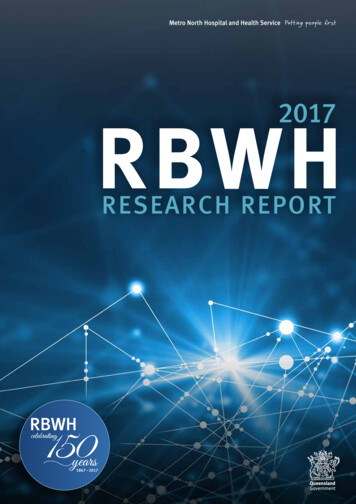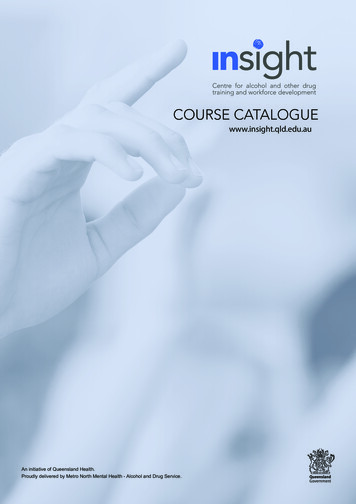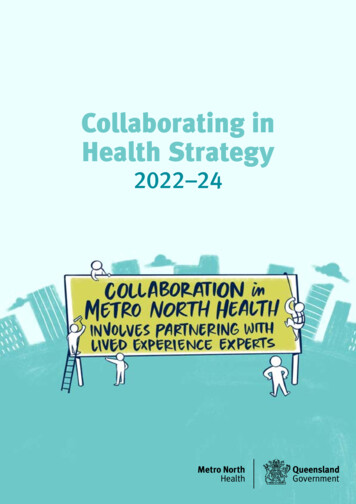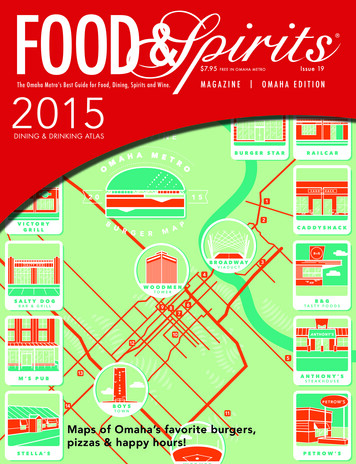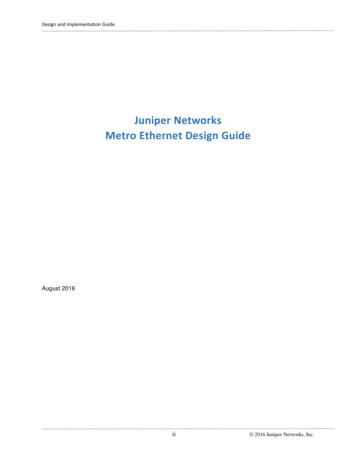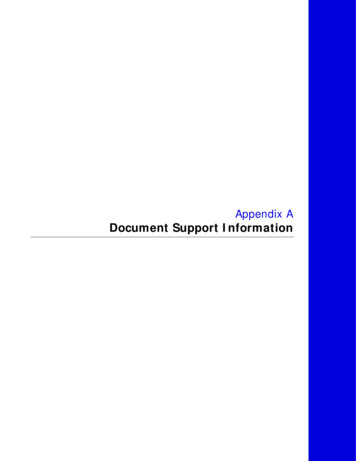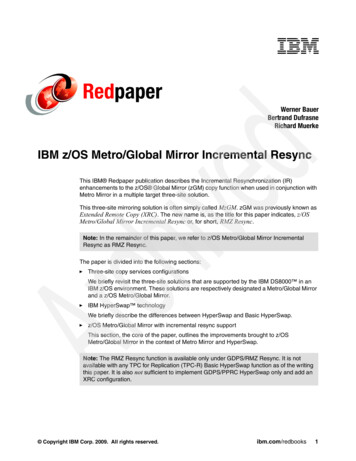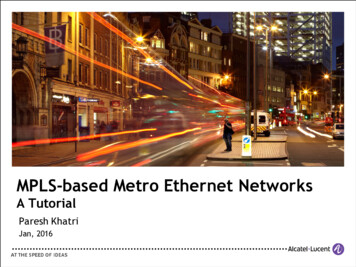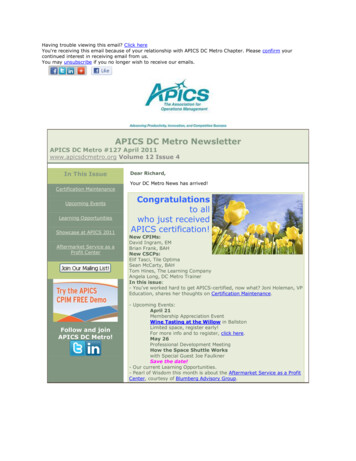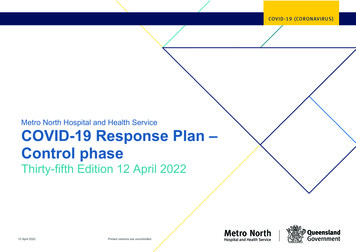
Transcription
Metro North Hospital and Health ServiceCOVID-19 Response Plan –Control phaseThirty-fifth Edition 12 April 202212 April 2022Printed versions are uncontrolled
Version controlVersion123456789101112Date released17 March 202027 March 20203 April 20209 April 202017 April 202024 April 20201 May 202015 May 202029 May 202012 June 202010 July 202031 July 2020Version131415161718192021222324Date released21 August 202024 August 20204 September 202025 September 202023 October 202021 December 20208 January 20215 March 202125 March 20211 April 202130 April 202131 May 2021Version2526272829303132333435Date released29 June 20212 August 20213 August 202124 September 202126 October 20219 December 202121 December 202118 January 20223 February 202228 February 202212 April 2022Published by the State of Queensland (Metro North Hospital and Health Service), April 2022This document is licensed under a Creative Commons Attribution 3.0 Australia licence.To view a copy of this licence, visit creativecommons.org/licenses/by/3.0/au State of Queensland (Metro North Hospital and Health Service) 1019You are free to copy, communicate and adapt the work, as long as you attribute the State of Queensland (Metro North Hospital and Health Service).For more information, contact: Metro North Emergency Management and Business Continuity, Metro North Hospital and Health Service, Block 7, RBWH, Herston QLD 4029,email MN-EmergencyManagement@health.qld.gov.au, phone 07 3647 8006.Disclaimer:The content presented in this publication is distributed by the Queensland Government as an information source only. The State of Queensland makes no statements, representations or warranties about the accuracy, completeness or reliability of anyinformation contained in this publication. The State of Queensland disclaims all responsibility and all liability (including without limitation for liability in negligence) for all expenses, losses, damages and costs you might incur as a result of the informationbeing inaccurate or incomplete in any way, and for any reason reliance was placed on such information.12 April 2022Printed versions are uncontrolledPage 2 of 45
ContentsContents . 3Abbreviations . 511.11.21.31.4Introduction. 6Situation. 6Purpose . 6Authority . 6Scope . 722.1Pandemic phases . 7National and State policy decisions . 933.1Overview of Metro North and infrastructure. 9Infrastructure . 104Community and Stakeholder engagement . 115Roles and responsibilities . 1166.16.26.36.46.56.66.76.86.96.10Control phase responses . 11Metro North Response . 11Patient and Family Engagement . 27COVID-19 Vaccination . 27Human resources . 27Aboriginal and Torres Strait Islander people . 30Vulnerable groups . 30Financial management . 31Private Hospitals . 34Influenza . 34Recovery strategies . 3512 April 2022Printed versions are uncontrolledPage 3 of 45
7Recover . 36Appendix 1Infrastructure at Tier level . 37Appendix 2Definition of essential meeting . 39Appendix 3PPE Response guide . 40Appendix 4Metro North Health Pandemic (COVID-19) Surge Workforce Response Plan. 4312 April 2022Printed versions are uncontrolledPage 4 of 45
GPHCHEOCHIUHICHLOIAPICTICUILIIMSIMTLDMGMN – EMCMN – EMP12 April 2022Adverse Events Following ImmunisationAustralian Health Protection Principle CommitteeBusiness as UsualChief Executive, Metro North Hospital and Health ServiceChief Health OfficerCommunity, Indigenous and Sub-acute ServicesDistrict Disaster Coordination (Queensland Police Service)District Disaster Management GroupEmergency Management PlanEmergency Operations CentreEmergency Response PlanGeneral PractitionersHospital CommanderMetro North Hospital and Health Service EmergencyOperations CentreHealth Improvement UnitHealth Incident ControllerHealth Liaison OfficerIncident Action PlanInformation and Communication TechnologyIntensive Care UnitInfluenza-like IllnessIncident Management SystemIncident Management TeamLocal Disaster Management GroupMetro North Emergency Management CommitteeMetro North Hospital and Health Service EmergencyManagement PlanPrinted versions are uncontrolledMN - EMUMN – ERPMN – MSRACFRBWHSETSHECCSITREPSMEACTPCHMetro North Emergency Management UnitMetro North Hospital and Health Service EmergencyResponse PlanMetro North Hospital and Health Service IncidentManagement TeamMetro NorthMetro North Hospital and Health ServiceMetro North Public Health UnitMemorandum of UnderstandingNational Disability Insurance SchemeNatural Disaster Relief and Recovery ArrangementsNational Medical StockpilePatient Access and Coordination HubPolymerase chain reactionPersonal Protective EquipmentQueensland Ambulance ServiceQueensland Disaster Management ArrangementsQueensland Health Incident Management SystemResidential Aged Care FacilitiesRoyal Brisbane and Women’s HospitalSenior Executive Team (Metro North Hospital and HealthService)State Health Emergency Coordination CentreSituation ReportSituation, Mission, Execution, Administration,CommunicationThe Prince Charles HospitalPage 5 of 45
1IntroductionSituation1.1In December 2019, China reported cases of viral pneumonia caused by a previously unknown pathogen that emerged in Wuhan, China. The pathogen was identified as a novel(new) coronavirus (recently named severe acute respiratory syndrome coronavirus 2 (SARS-CoV-2)), which is closely related genetically to the virus that caused the 2003outbreak of Severe Acute Respiratory Syndrome (SARS). SAR-CoV-2 causes the illness now known as Coronavirus disease (COVID-19).Tests to detect COVID-19 in Queensland include the Polymerase Chain Reaction (PCR), carried out at testing clinics and the Rapid Antigen Test (RAT), performed at home orused in health facilities as a screening tool. Individuals no longer need a PCR test to confirm a positive RAT. Individuals are required to report positive RAT using an onlineregistration form.Vaccines approved for use in Australia by the Therapeutic Goods Australia currently include Vaxzevria (Astra Zeneca), Comirnaty (Pfizer), Spikevax or Takeda (Moderna) andCOVID-19 Vaccine Janssen (Janssen). Vaccines are available to persons aged 5 years and older.Treatments that have been provisionally approved by the TGA for use in Australia include regdanvimab (REGKIRONA), tocilizumab (ACTEMRA), casirivimab imdevimab(RONAPREVE), Sotrovimab (XEVUDY), and remdesivir (VEKLURY). The TGA has also approved a number of treatments under a provisional registration (effective for sixmonths) for promising treatments as a means of expediting promising new treatments with preliminary clinical data. Clinical guidelines may recommend the ‘off-label’ use ofsome medicines already included in the Australian Register of Therapeutic Goods (ARTG) for example dexamethasone.1.2PurposeThe purpose of this pandemic response plan (Metro North COVID-19 Response Plan), is to ensure continuity of health services and manage the number of cases in thecommunity. All measures are consistent with the National Plan to transition Australia’s National COVID-19 Response where priority is given to vaccination consolidation phaseactivities which seek to minimise serious illness, hospitalisations and fatalities as a result of COVID-19. Given the rapid rate of change, this will remain a living document whichwill be updated as decisions are made throughout the pandemic. The strategic objectives for the Metro North response are: the safety of staff by minimising risk to staff responding to COVID-19 through appropriate training, personal protective equipment (PPE) and infection control practices the safety of community by minimising the transmission of COVID-19 within the Metro North community and within healthcare settings through proactive identificationand targeted testing, effective infection control activities, and community messaging ensuring Metro North maintains critical services continuity maximise the health outcomes of peoples with COVID-19.1.3AuthorityThe World Health Organisation (WHO) declared that outbreak of COVID-19 a Public Health Emergency of International Concern on 30 January 2020.12 April 2022Printed versions are uncontrolledPage 6 of 45
Nationally, the Biosecurity Act 2015 and the National Health Security Act 2007 authorises activities to prevent the introduction and spread of diseases in Australia and theexchange of public health surveillance information (including personal information) between state and territory government, the Australian Government and the WHO.The Queensland Department of Health declared a public health event of state significance under the Public Health Act 2005 on 22 February 2020. The issue of Public HealthAgreements are issued by designated Emergency Officers (Environmental Health Officers) under this act. The issuance of a Detention Order by an Emergency Officer(Medical) (Public Health Physicians) is also under this Act. During a public health emergency, the Chief Health Officer (CHO) can issue Public Health Directions to assist incontaining, or responding to, the spread of COVID-19 within the community. The latest directions are available in Section 2.1.The COVID-19 response within Metro North is authorised by the Health Incident Controller (HIC) under the Metro North Emergency Management Plan.The Metro North Public Health Unit function is critical to containing and responding to the COVID-19 outbreak with expertise drawn from public health and infection controlnurses, epidemiologists, doctors, environmental and public health officers. The Metro North Public Health Unit follows the advice and recommendations (with local adaptation)contained within the Communicable Diseases Network Australia (CDNA) National Guidelines for Public Health Units: Coronavirus Disease 2019 (COVID-19) which providesnationally consistent advice and guidance to public health units in responding to the COVID-19 outbreak. Current functions of the Metro North Public Health Unit include: Provide information and guidance to general practitioners and the public regarding testing and isolation requirements Management of contacts – active contract tracing towards high-risk settings and high-risk close contacts only Notification of only major outbreak venues or super-spreader events. Undertake compliance and monitoring of Chief Health Officer directions to persons and businesses/industry1.4ScopeMetro North has entered the control phase (refer to Figure 1 below) of the pandemic. This Plan describes the actions that Metro North is undertaking to ‘live with COVID-19’ inthe community. A vaccine is widely available and vaccination rates are high in Queensland. The Plan’s activities are in alignment with the National Plan to transition Australia’sNational COVID-19 Response.This Plan is supported by detailed subplans for Directorates, clinical streams and corporate functions and builds upon previous iterations of the Metro North COVID-19Response Plan.2Pandemic phasesAustralian pandemic phases are based on the WHO phases but are designed to describe the situation in Australia and to guide Australia’s response. Thus, the Australian andthe WHO phase may not always be the same. The Australian phases describes whether the virus is overseas (OS) or in Australia (AUS). Different response strategies may beused simultaneously in different parts of Australia, due to variations in the local stage of a pandemic. Having an Australian system means that actions can be taken in Australiabefore a change of phase is declared by the WHO.Figure 1 Pandemic phases and description, Australia12 April 2022Printed versions are uncontrolledPage 7 of 45
PhaseDescriptionALERTOS3A novel virus with pandemic potential causes severe disease in humans who have had contact with infected animals. There is no effectivetransmission between humans.Novel virus has not arrived in Australia.DELAYOS4/OS5/OS6Novel virus has not arrived in Australia.OS4Small cluster of cases in one country overseas.OS5Large cluster(s) of cases in only one or two countries overseas.OS6Large cluster(s) of cases in more than two countries overseas.CONTAINAUS 6a - January 2020Pandemic virus has arrived in Australia causing small number of cases and/or small number of clusters.SUSTAINAUS 6b – 25 March 2020(Metro North)Pandemic virus is established in Australia and spreading in the community.CONTROL AUS 6c –September 2021Customised pandemic vaccine widely available and is beginning to bring the pandemic under control.RECOVER AUS 6dPandemic controlled in Australia but further waves may occur if the virus drifts and/or is re-imported into Australia.Note 2008 Australian Phases version used over 201912 April 2022Printed versions are uncontrolledPage 8 of 45
2.1National and State policy decisionsDuring a public health emergency, the CHO can issue Public Health Directions to assist in containing, or to respond to, the spread of COVID-19 within the community. Thelatest Queensland CHO Directions include are listed below (December 2021 onwards). Refer to the Chief Health Officer public health directions site for a full list of publichealth directions.Requirements for Workers at Government Nominated Accommodation DirectionDisability Accommodation Services DirectionHome Quarantine for Household Members of an Overseas Traveller DirectionHospital Entry DirectionMandatory Face Masks DirectionQuarantine for International Arrivals DirectionResidential Aged Care DirectionUse of Technology to Support Home Quarantine DirectionIsolation for Diagnosed Cases of COVID-19 and Management of Close Contacts DirectionCOVID-19 Hotspots and Border Zone DeclarationBorder Restrictions DirectionQuarantine and COVID-19 Testing for International Air Crew DirectionPublic Health Face Mask Requirements DirectionQuarantine for International Arrivals DirectionPublic Health and Social Measures linked to vaccination status DirectionPoint of Care Rapid Antigen Tests for COVID-19 for Queensland Public Hospitals DirectionManagement of Close Contacts DirectionManagement of Secondary Contacts DirectionQueensland Travel Declaration DirectionWorkers in a healthcare setting (COVID-19 Vaccination Requirements DirectionCOVID-19 Vaccination Requirements for Workers in a high-risk setting Direction 3Overview of Metro North and infrastructureMetro North has a local population of over one million people (1,046,494 - 2019 preliminary estimated resident population), in an area stretching from the Brisbane River tonorth of Kilcoy. Clinical services are provided at The Royal Brisbane and Women’s (RBWH), The Prince Charles Hospital (TPCH) Redcliffe Hospital, Surgical Treatment andRehabilitation Service (STARS), Caboolture Hospitals, Kilcoy Hospital and at the Woodford Correctional Facility. Mental health, oral health, Indigenous health, subacuteservices, medical imaging and patient services are provided across many sites including hospitals, community health centres, residential and extended care facilities, andmobile service teams. Metro North has a dedicated Public Health Unit.12 April 2022Printed versions are uncontrolledPage 9 of 45
There are 341 general practices in the Metro North region 1. Over one quarter of general practices (26.1 per cent or 89 practices) are located in the Brisbane Inner City subregion, followed by the Brisbane North sub region, with 19.6 per cent (67 practices).There is a total of 7,113 residential aged care places in the region, representing 73 residential aged care places per 1000 people in the region 2.There are 23 private hospitals in Metro North, 7 hospitals with general overnight beds, 14 with day surgery facilities and 3 mental health facilities.Hospitals with overnight bedsBrisbane Private HospitalCaboolture Private HospitalPeninsula Private HospitalSt Andrew's War Memorial HospitalSt Vincent’s Private Hospital NorthsideThe Wesley HospitalNorth West Private Hospital3.1Day surgery facilitiesChermside Day HospitalPacific Day Surgery CentreEye-Tech Day SurgeriesQueensland Eye HospitalMarie Stopes Australia Bowen Hills DayRivercity Private HospitalSurgerySamford Road Day HospitalMontserrat Day Hospitals (Indooroopilly)Spring Hill ClinicMoreton Day HospitalSpring Hill Specialist Day HospitalNorth Lakes Day HospitalWestside Private HospitalMental Health facilitiesNew Farm ClinicPine Rivers Private HospitalToowong Private HospitalInfrastructureThis section provides an overview of the baseline infrastructure across Metro North relevant to the pandemic response.Public HospitalsTotal bedsED treatmentspacesICU bedsIsolation roomsMortuaryPublic2,1261556842361 AdultRBWH83447366719 adult, 17 31258389Kilcoy210040STARS182NANA1350*bed alternatives excluded12Brisbane North PHN, 2019Department of Health, 201612 April 2022Printed versions are uncontrolledPage 10 of 45
As demand on the health service fluctuates, Metro North may establish contractual arrangements with a number of private facilities in the region to be transfer and refer patientsto these facilities to increase access to public beds for COVID-19 positive patients.4Community and Stakeholder engagementMetro North will continue to communicate and engage with a broad range of key stakeholders during the control phase response.5Roles and responsibilitiesMetro North will lead the implementation of response requirements at a HHS level, in alignment with the National Plan to transition Australia's National COVID-19 Response,and Queensland’s COVID-19 Vaccine Plan to Unite Families.6Control phase responsesThe control phase will continue to require a statewide approach to managing any outbreaks. Since the pandemic began, there have been a number of variants of COVID-19and our response needs to be agile enough to respond to these known variants as well as any future variants. As the largest provider of public healthcare in the State, MetroNorth will support Central West HHS and Norfolk Island in their COVID-19 response and management. As numbers of COVID-19 positive people increase it is anticipated thata number of Metro North staff will either be positive or furloughed and this may impact our response. In addition, Metro North may be required to support other HHS either withaccess to beds, workforce or other services, including virtual services. All Metro North facilities will treat COVID-19 positive patients.6.1Metro North ResponseThe Metro North response plan outlines a tiered response, spanning from Tier 0 to Tier 5 (see below) which is in alignment with the Department of Health’s COVID-19response. Triggers are determined for each phase however they may vary for each facility depending on their baseline capacity and capability. Baseline and surge capacity isoutlined in Appendix 2 and 3. Each Directorate has a local COVID-19 Response Plan which aligns with the Metro North directions below. Where a Directorate identifies theneed to activate a change to service provision (such as provision of subacute services at one site) consultation and collaboration should occur with the Metro North executiveand other facilities that may be impacted by the decision.Transitioning to another Tier will require the prior approval of the Metro North Chief Executive, who in turn will brief the Metro North Board and Department of Healthrepresentative.PPE risk will continue to be monitored separately to the tiered response, as per the sustain phase. For example, there may be lower community transmission placing the HHS inTier 1, however due to the number of close contacts of the person who is positive for COVID-19 there may be a moderate risk of transmission. Further information on theimplications for PPE use based on risk assessment is available in section 6.1.8.712 April 2022Printed versions are uncontrolledPage 11 of 45
6.1.1 Tier 0: Prevent local transmissionGovernance IMT activeEOC – stood upReport PPE daily, weekly PPEstocktakeMedication stocktake at each siteweeklyMN Response – Strategic PlanningGroupSHECC twice weekly reportingPersonnelStaff wipe down personal ipads/phones;wipe down hard surfaces establish weekly communication withstaff – vidcasts, emails, asappropriatesVisitors do not attend if unwell, as per CHOdirectionVolunteers do not attend if unwell, completevolunteer checklist, risk assess roles,engaged as appropriateConsumer representation complete Consumer COVID checklist,risk assess rolesMeetings Adhere to social distancing Virtual meetings where ableActivate Metro North meetings – MN COVID-19 IMT – twice weekly MN Response – Strategic PlanningGroup – twice weekly MN EOC Logistics Team MN PPE Usage update MN PPE Clinical advisory group –determine frequency as appropriateFever ClinicAdjacent or external to ED,community-based – adjust capacitybased on demand No restrictions – social distancing tobe observedPPE training for all staffAssess PAPR protocols, cleaningand training 12 April 2022Printed versions are uncontrolled Service Operations TrainingIdentify locations in ED for patientswith ILI symptoms.Implement hypervigilant screening/testingAll non-urgent review appointmentsto be done virtually.Consider patients wearing masks forOPD clinics where social distancingis not possibleIncrease procedural and outpatientclinic activity to address any demandissues – maximise category 1 and 2,focus on category 3 waiting longerthan 240 days and current long waits.Utilise flexible theatre templatesOutsource activity where appropriateService OperationsMaintain as isCOVID-19 positive patients Meetings EDTraining ICUSingle rooms, isolatesuspected/confirmed COVID-19patients or those in quarantineVirtual Ward – as requiredMinimise movement of inpatients withconfirmed or suspected COVID-19within wards or across the hospital,use portable x-rays and ultrasoundswhere able.All blood collection and ancillaryservices managed within the wardLow intensity COVID-19 wardFacility Signage at entrances alertingpatients, visitors and staff not to entera health service if unwellEntrances/Exits – separate staffentrances, sanitising stations at allentrancesFast track all patients with fever 37.5 to ED Triage or Fever ClinicSecurity – maintainCleaning - frequent touch pointcleaningPharmacy – maintain 6 monthssupply of pharmacy stocks (based onusual supply)FacilityPage 12 of 45
Outpatients supplied with one monthof medication.Outreach services to continue Consider allocation of CT scanner forsuspected or confirmed COVID-19patientsFood, linen and waste services – usePPE in accordance with QueenslandHealth and Metro North guidance6.1.2 Tier 1: Limited community transmission*Note: additional measures to those below may be implemented for periods of time at the discretion of the CHO or the Metro North executive if deemed necessary.Governance PPE stocktake - if stocktake varianceexceeds 5% (of prior day’s closingbalance) for three consecutiveweeks, change to daily stocktake12 April 2022PersonnelStaff All staff must be vaccinated PPE wearing as per PPE risk level All staff to be fit tested for at least 2masks minimise staff movement acrosswards and facilities develop staff teams and minimisecontact between teams consider roles that can work remotely discourage congregation in tearoomsand other shared spaces enact staff management plans activate COVID-19 HR hotline –hours as demand indicates Increase capability in casual pools Develop and maintain a COVIDresponse extranet page daily communication with all staffVolunteers and consumers - engage inlow risk roles, onsite arrangements asper visitor directions unless individualhas had first vaccination at least 10 daysago and consent to be on siteVisitors – as per CHO DirectionPrinted versions are uncontrolledFever Clinic Increase and/or reallocateInvestigate locations to move fever clinicsaway from EDICU ED Relocate ED patient cohorts to alternatelocation outside ED as required e.g. fasttrack to OPD, to allow space for influenzalike illness patients to be separatedIncrease and/or reallocate staffUtilise Virtual EDChildren requiring ICUtreatment will be transferred viaQAS to QCHInvestigate locations to providehigh flow oxygen outside of ICUfootprintCOVID-19 positive person Assess need for DesignatedCOVID-19 wardsGP pathway for COVID-19positive patients implementedas appropriateVirtual Ward capacity increasedLow intensity COVID-19 wardIncrease and/or reallocate staffMinimise inter-hospital transfersof suspected or confirmedCOVID-19 patients unlesshigher level care is indicatedIdentify locations for massinfusions for delivery ofmonoclonal antibodiesPage 13 of 45
Students – as per CHO DirectionMeetings TrainingDiscretionary suspension of nonessential meetings where theyimpact on clinicians’ time to respondto COVID-19 Activate Directorate IMT and relatedmeetings – determine frequency asappropriate Increase frequency of MN IMT – based on need MN Response – Strategic Planning –based on need Discretionary suspension of nonessential training where they impacton clinicians’ time to respond toCOVID-19Adhere to social distancingEssential training to be deliveredvirtually where ableContinue PPE trainingContinue PAPR trainingContinue OVP trainingContinue infection control trainingCommence ICU upskillingCommence identification of nursingstaff to assist in specialist units suchas dialysis and SCN/NICUService Operations 12 April 2022Printed versions are uncontrolledPatients to wear level 1 surgical masks forOPD clinicsMaintain activity and critical referrals infrom other HHSsIncrease virtual careIncrease HITH capacity including virtualcapabilityIncrease use virtual models for outreachservices where ableIdentify locations outside of the outpatientclinic to provide virtual clinicsOutbreak management – reallocation ofstaff to other sites.Reallocate staff to frontline roles asdemand dictatesPrepare processes to enable suspensionof Category 3 and 6 surgery, medical andnon-emergency dental procedural activitywhen advised to deploy these staff toCOVID -related care including extraCOVID inpatient wards, virtual ward, feverclinics etc . NOTE: suspension of activitynot to occur
For more information, contact: Metro North Emergency Management and Business Continuity, Metro North Hospital and Health Service, Block 7, RBWH, Herston QLD 4029, email MN-EmergencyManagement@health.qld.gov.au, phone 07 3647 8006.
